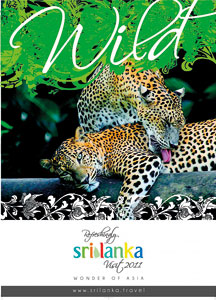A poster showing a pair of Sri Lanka leopards has been named Best Poster for the South Asia Region in an international competition.
The poster was created and submitted by Sri Lanka Tourism for the Vettor Giusti Tourism Poster Competition, which is held once in two years to mark the United Nations World Tourism Organisation (UNWTO) General Assembly sessions.
The winning posters will be on display in the entrance hall of the UNWTO building in Madrid, Spain. Sri Lanka Tourism has launched a campaign under the banner, “Refreshingly Sri Lanka”, leveraging on the country’s natural wealth and beauty. The content of the campaign falls into eight categories, based on the eight letters that spell “Sri Lanka.” As a tourism destination, the country can boast of a wide range of wildlife – from the leopard and the sloth bear to the elephant and the blue whale – all encompassed in a relatively small geographical area, the campaign points out.
Sri Lanka has the potential to become the “Wildlife Wonder of Asia” as long as the country’s tourism potential is properly tapped, say conservationists. Feedback from visitors suggest that this is not happening.
Answering a recent survey questionnaire, tourists said they were “satisfied” with the wildlife experience in game reserves in general, but not with the “overall experience.” They cited setbacks such as a lack of knowledgeable guides, congestion in parks, and negative behaviour by jeep drivers who disturbed animals. They also mentioned park infrastructure deficiencies, such as inadequate visitor centres and unclean toilets. All these factors, they said, prevented them from describing their visit to Sri Lanka as “memorable.”
Tourists mentioned popular national parks in other countries where visitor numbers and conduct within parks are monitored.
In India, many of the tiger reserves have a daily quota for vehicles permitted inside, and strict rules on the number of vehicles allowed per route. In game reserves in South Africa, only a limited number of safari jeeps are allowed for each wildlife sighting, and only one vehicle at a time is permitted at an observation point. In Ruwanda, a maximum eight visitors at a time are allowed to observe the rare Mountain Gorillas.
The fact that all these tours are always fully booked attests to visitor satisfaction with the arrangements. The “sustainable tourism” lobby in Sri Lanka would like to see Sri Lanka pitched as a high-end conservation tourism destination, while avoiding the pitfalls of mass tourism. This would be economically beneficial and protective of the wildlife within the wildlife parks, they say.
The Sri Lanka Tourism Promotion Bureau is working closely with conservationists to promote regulated, well-conducted wildlife tourism.
Vipula Wanigasekera, acting director-general of Sri Lanka Tourism, told the Sunday Times that research was being done to determine visitor capacity for Yala National Park, and that an action plan was being drawn up.
As a first step, Sri Lanka Tourism and other animal welfare groups are training Yala trackers in game reserve best practices, as observed in other tourism-dedicated countries.
Activists say the Department of Wildlife Conservation needs to boost its resources and beef up its numbers in order to manage visitors. More trained guides are urgently needed, they say. |


